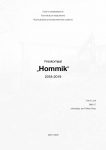Frank Lukk
- Faculty of Art and Culture
- Cultural Heritage and Conservation
- ba
- Freskomaal Hommik 2018-2019
- Juhendaja(d): Hilkka Hiiop

Tallinn’s first widescreen cinema “Rahu” (“Peace”) was opened on June 26th 1959. Structure was built according to the union wide standard project No 2-06-25 and could seat over 500 guests. Cinema remained working until 1995.
In spring 1962 Dolores Hoffmann defended her diploma thesis “Hommik” – reduced layout of a fresco wallpainting and a separate detail view as an oil painting on canvas (190x285cm). Year later, after practicing fresco techniques in Leningrad, author painted monumental fresco on the wall of the second floor hall in cinema “Rahu”. Although the painting did not follow the terms of social realism which still was the main line of art, the fresco was accepted by the Ministry of Culture in such widely used public space as a cinema. Composition of fishermen followed by their wives going to sea during sunrise symbolizes peace itself not fight for peace, which was rather more common when ‘peace’ as theme was concerned. When the 75 m2 fresco was completed in 1963, there were almost no reviews nor critics about the painting.
In 2007 the city council had given a permit to demolish the building but it was not realised. Ten years later the demolition topic came back on the agenda. This time the city’s heritage board intervened and the building was taken under temporary protection to figure out the future of the huge wallpainting. The solution that was suitable for both the owner and the heritage board did not represent the common practice of modern heritage protection – partial detachment of the painting. Rest of the remaining painting was demolished with the building in April 2019.
The owner and heritage board settled on a compromise of detaching and remounting 10 m2 of fresco in the new building that will stand in the place of demolished cinema. The conservation team used more sensitive method for detachment process compared to the traditional detachment methods like strappo and stacco. Sawing thin layer of plaster with the fresco on it off the wall allowed to remove selected fragments of fresco without almost no damage at all.
As a student workshop, in addition to the 10 m2 request, moreover than 30 m2 of wallpainting was detached, reinforced and framed as a separate pieces of art.
In autumn 2019, all the single fragments of the fresco were gathered for the exhibition in the gallery of Estonian Academy of Arts. Along with the exhibition, a documentary film and a booklet was published of the story of the painting and detachment process.
34 fragments, additionally to the 10 m2 detail, varying from 0,3 up to 1 m2 have now been distributed between different museums, institutions and people involved with the painting, as well as the author herself.
The 10 m2 detail although did not find its way to the new building in the place of cinema „Rahu” due to the complications with the real estate developer. Instead it will be remounted in another new building in Tallinn’s city centre in January 2020.



